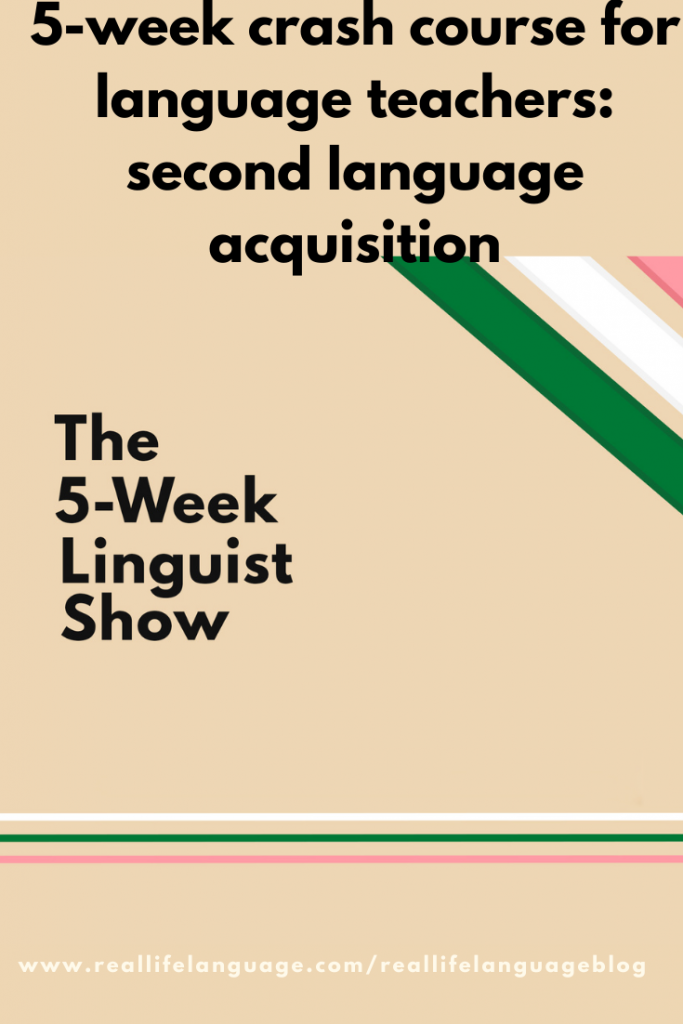
Second Language Acquisition
Welcome to the 5-Week Linguist Show. If you want to learn a language, or you teach a language, you’ve come to the right place. Join Janina each week for tips, resources and advice for making engaging language learning happen anytime, anywhere.
Welcome to the 5-Week Linguist Show. We’re wrapping up five weeks of getting the year started for language teachers, and I put together a little SLA, second language acquisition, crash course that I wanted to share with you. And I also put it together as a course in infographics that you can see over at the blog. And, of course, everything will be linked in the episode you’ll see.
And so my very first lesson is my checklist for a proficiency-oriented language class. And really we focus on what we can do, all of us, including the teachers, and not on what people can’t do. So it’s all about understanding that the focus is what we can do and what we can’t do. We have to accept that it’s going to be a while before we can do things. And to be able to get to that point we can’t put the focus on what we can’t do. It has to be all task-oriented. What are we learning how to do? What can we do?
Second Language Acquisition: Checklist for a Proficiency-oriented Language Class
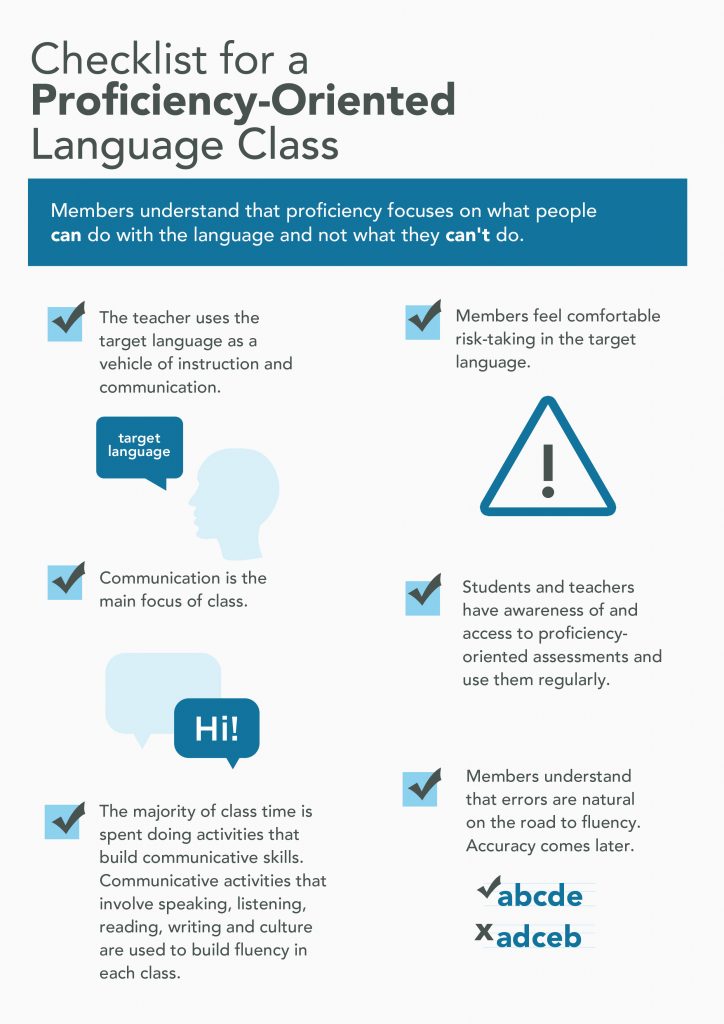
The target language is a vehicle of instruction and communication. I know that can be really hard sometimes, but that 90% is really important, even 100%. The only time that I find it really difficult to teach in the target language sometimes, is really the advanced classes with grammar, explaining, giving examples of grammar, verb, tenses, that kind of thing. That can be a little bit tricky. Sometimes students want a really clear example. But, with that said, all of that leads to communication. That’s got to be the main focus of the class, and that’s how you’re spending your time doing the class. They have to involve speaking, listening, reading, writing, and culture. They’re all used to build fluency in each class. And the environment we create, they need to be able to take risks. That’s how we move from what we can’t do to what we can do.
And we have lots of proficiency-oriented assessments, and we use them regularly. And errors are loved, we fall in love with errors, they’re expected on the road to fluency. You can see the infographic of my checklists. These are my essentials for my language class.
And my next bit is some notes, my path to fluency. And I made these notes when I was completing rating the Spanish speaking test from the Center for Applied Linguistics. And you can actually get certified with a program that they do. It’s a little bit different than getting certified to rate the actual OPI, it’s a lot less time intensive and so it was a lot more practical for my needs. It was some of the best professional development I ever did. And I took these notes, and this shows the actual scale from novice to, I believe, superior. I believe we went up to superior. And they’ve added another level.
Second Language Acquisition: The Path to Fluency

If you are from the common European framework for reference, those first bubbles are going to be the A level. The next group of bubbles are going to be where you’re talking about sentences, is going to be B, and then the bottom part is going to be C. So that’s a quick proficiency crash course of what we do in schools. We’re mostly dealing with the first bit, words and phrases, and we get into the intermediate. But that visual really helped me understand, that visual that’s from the actual notes that I took, and I had someone create a visual for me to help me see that path to fluency. That’s where we’re going. And we don’t go from the first part to the last part overnight. It’s a continuum, and we need to celebrate all of our accomplishments as we go.
The next one are the Foreign Service Institute categories. And these different language categories, I think they’re super-helpful. The Foreign Service Institute has done a lot of research and they’ve categorized languages. And they’ve done this for really practical reasons. They’re training diplomats for assignments abroad. So they’re constantly looking at how long they have to invest. How long do they and the students have to invest to be able to reach their exit proficiency levels? How many class hours, how many study hours? So I think it’s super-helpful to understand, for students and for us, learning Chinese is going to take you three to four times as long to get to that same level, than it’s going to take you to get in Spanish or French. And so I think it makes for really realistic expectations.
Second Language Acquisition: How Long does it Take?
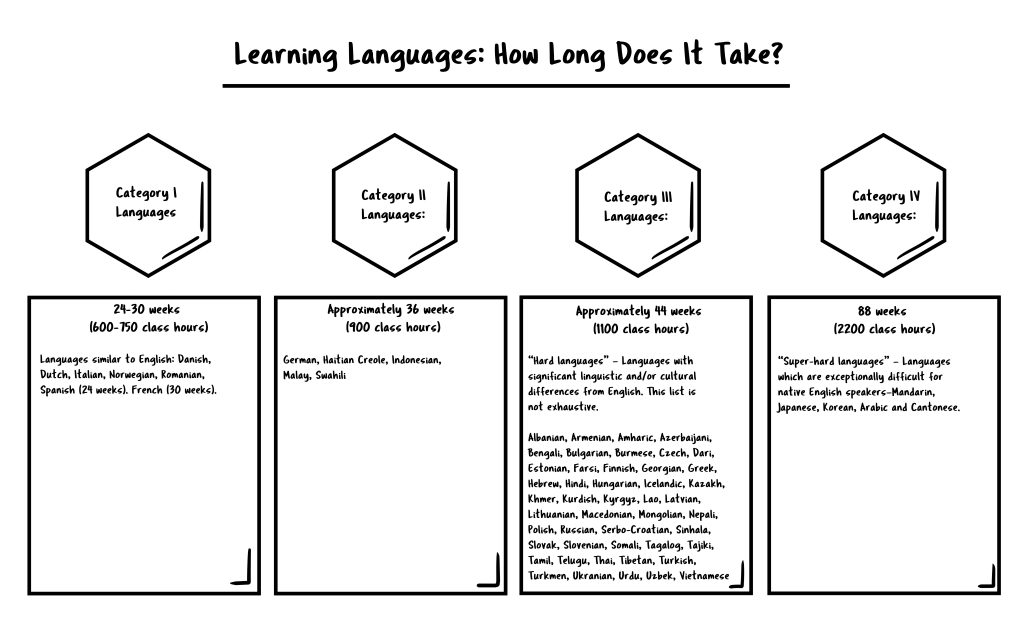
Those timeframes in those different categories are for people who work on languages full-time. But I just think there’s really great takeaways for language classes. We look at those class hours, if you added up your own class hours, what realistically would that mean in terms of the Foreign Service Institute? How far would you get? Would it be anywhere near the number of hours, to hit those levels of fluency? I also think it’s important conversation to have, moving forward as a profession. We really want those long sequences, we really want to produce speakers of languages. We need to do it over a long period of time, and not with an entire language compressed into a few textbooks, as we often see with these series. They start with survival language and they end with very complex structures by the end of year three. And I don’t believe that for the most part, this is being mastered all the time, to no fault of the students or the teachers. It’s just the amount of time that we have.
Next, my language is past and present. So many people experience languages in the past, and in all the great changes that have been made in the present, all the great technology and all the professional development that’s going on. It’s gone from a content area to a lot more interactive, and with lots of resources.
Second Language Acquisition: Learning in the Past and Present
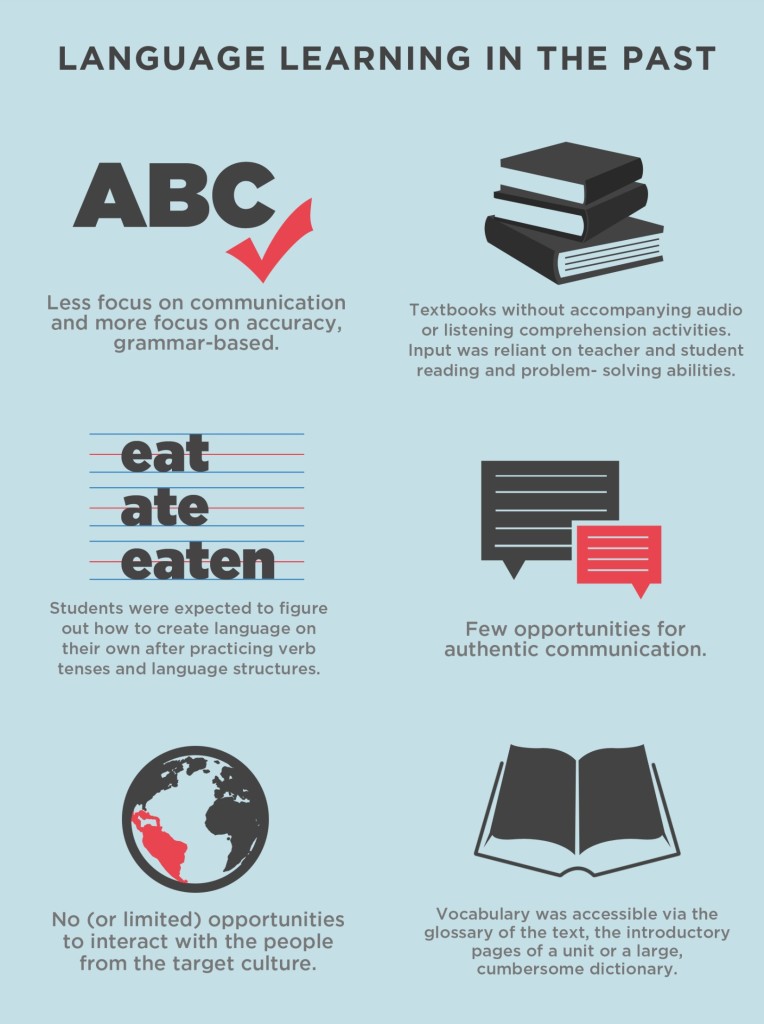
Next, I share my graphic for a crash course for reading in foreign languages. And I talk about how to use reading to to use languages. You’ve got to learn to read, and then you’ve got to read to learn. But use all those tools, use tools to help dig deep into understanding, because your literacy skills are transferable.
Second Language Acquisition: Reading
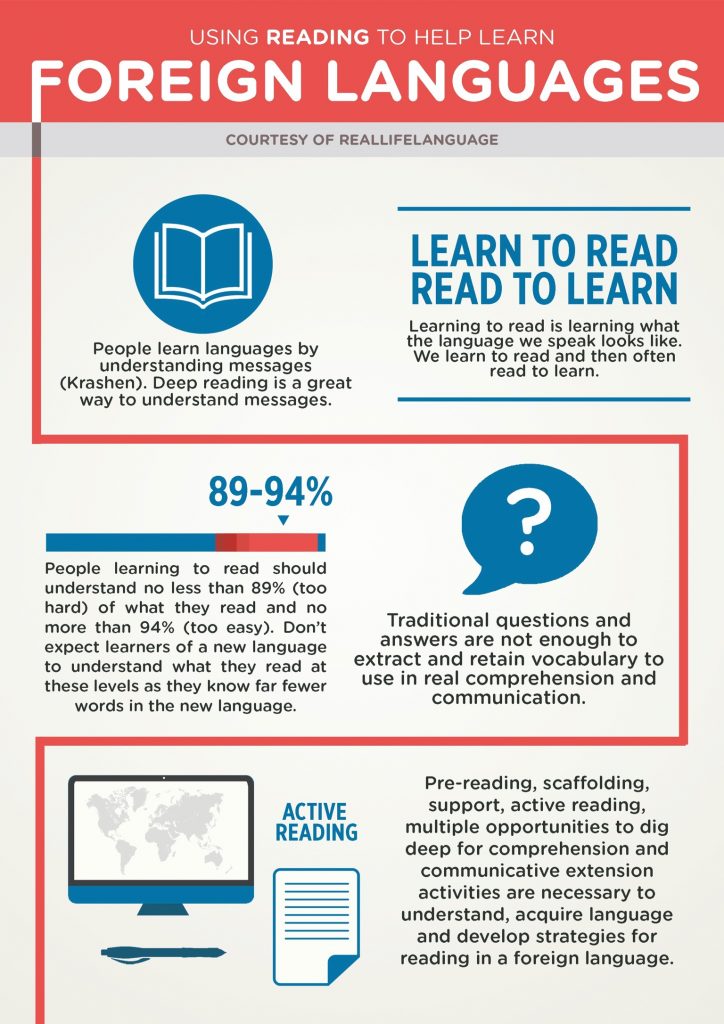
Second Language Acquisition: Culture
Culture, we need to invest in teaching culture. And this can be a really hard thing. It’s a fun thing, but it can be a hard thing, curating all the right materials to be able to do it on a regular basis, to tie this into all of our communicative acts and not make culture something separate and different from language, to really keep those things together
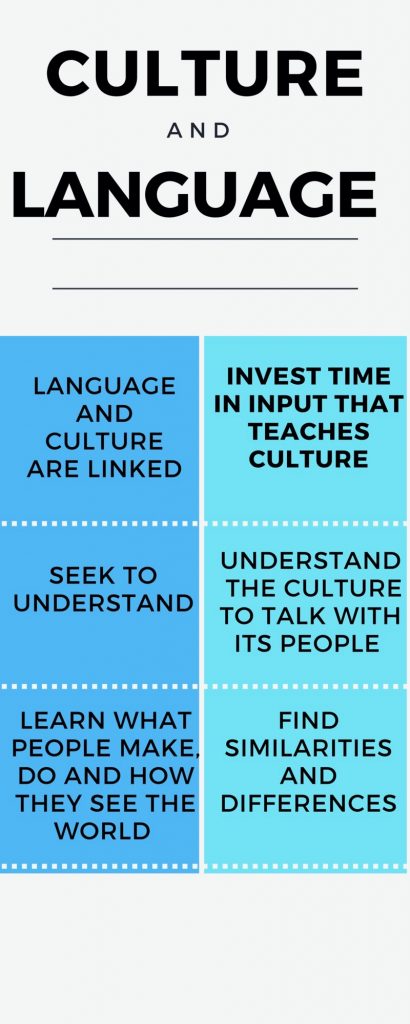
And next I have the perfect marriage. And this came to me thinking about Krashen’s theory of language acquisition. And one of the five is learning acquisition. So learning, or all the deliberate things that we do to learn languages, talking about verb tenses, practicing, exercises, that sort of thing. And acquisition is the way we naturally learn. I think that we focus a lot on acquisition now, which is fantastic, on comprehensible input, et cetera. However, I don’t think the learning should be ignored. And in fact when you put these two things together, that’s the key to rapid success. Learning, acquisition, together are the perfect marriage.
Second Language Acquisition: The Perfect Marriage
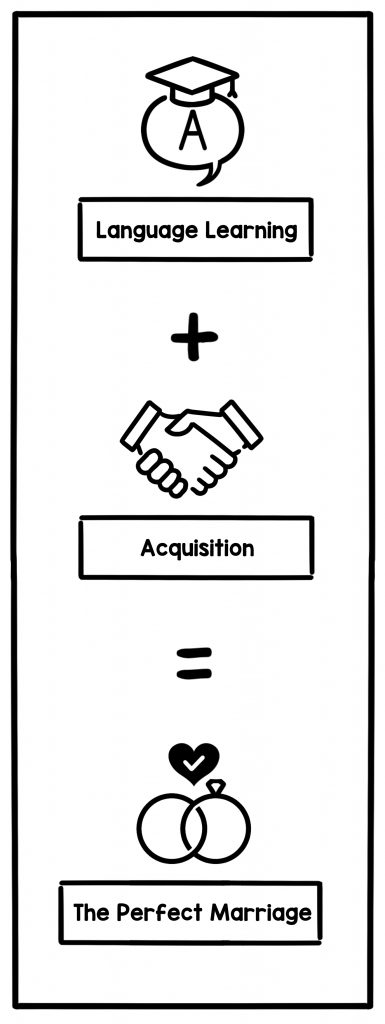
And lastly, my very simple formula. Time, investing that time, into tasks, learning things that we can do, learning to do things in the new language, equals fluency.
Second Language Acquisition: Time
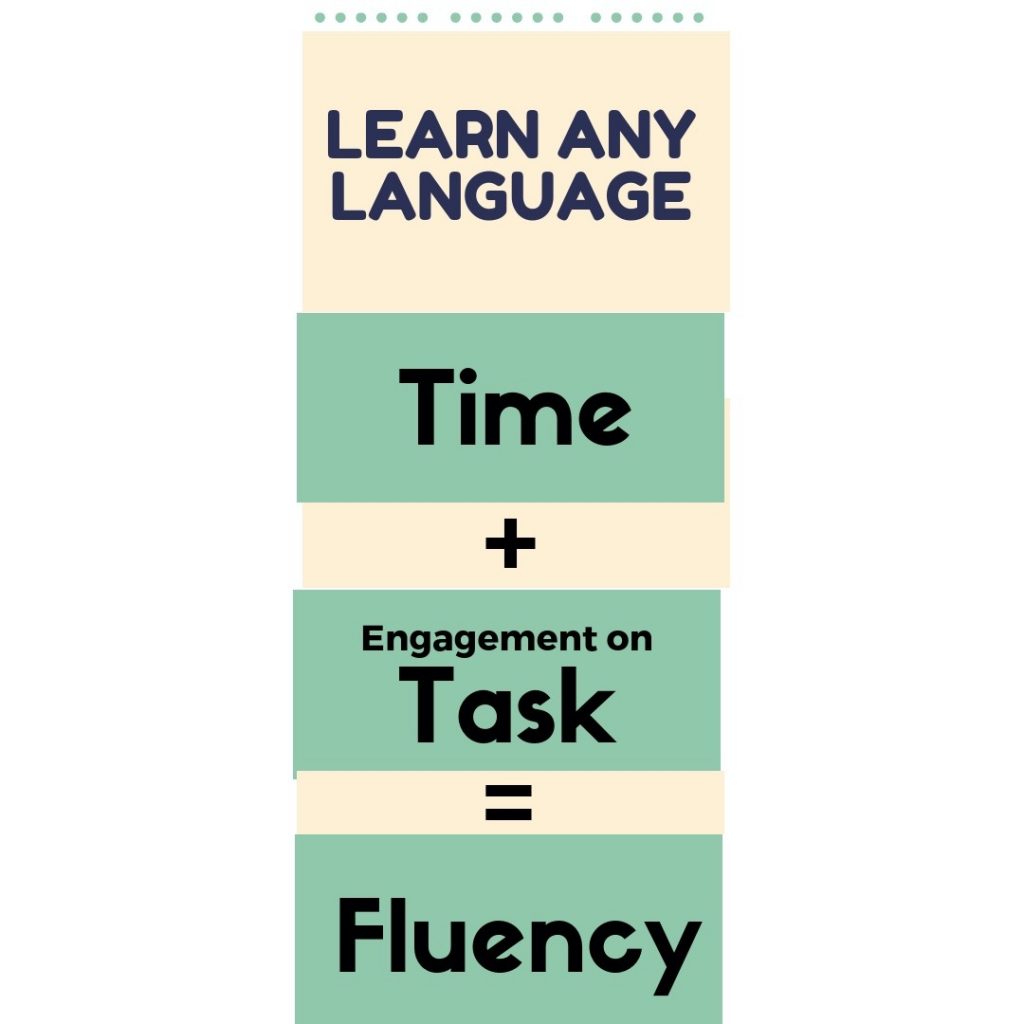
I hope you have a wonderful school year. Until next time.
Thank you for listening to the 5-Week Linguist Show with Janina Klimas. Join us each week here, and visit us at reallifelanguage.com/reallifelanguageblog for more resources for learning and teaching languages.
Looking for more resources for your classes? https://reallifelanguage.lpages.co/language-lessons-5-weeks-of-low-and-no-prep-fun/
Podcast: Play in new window | Download
Subscribe: RSS